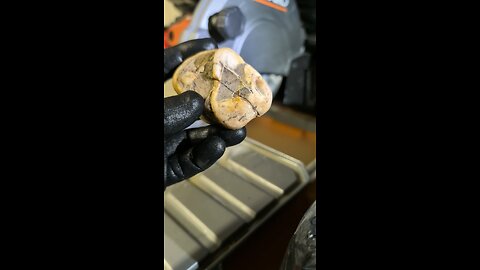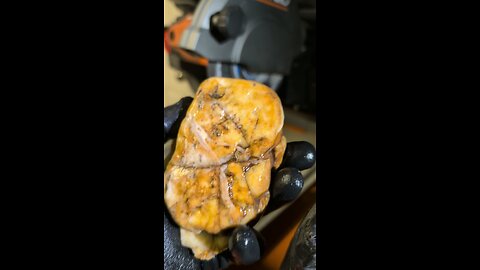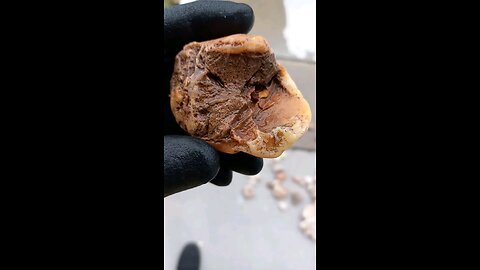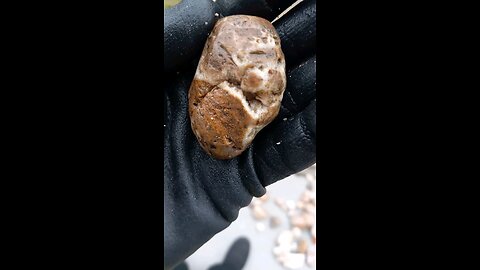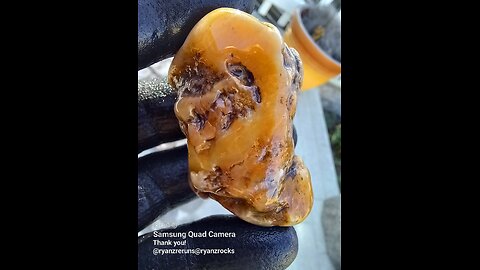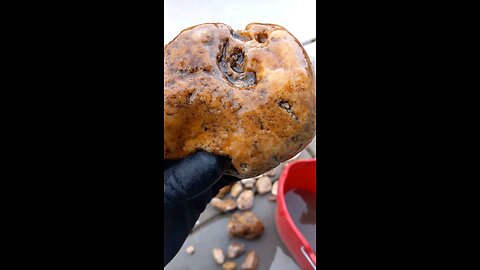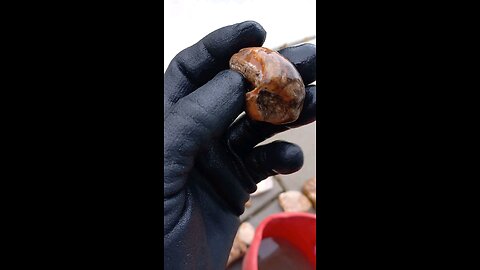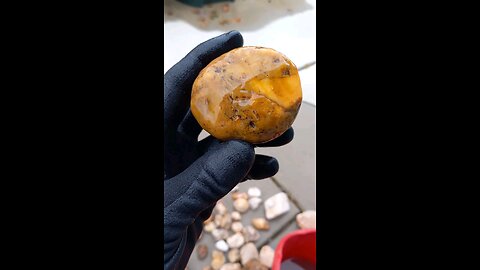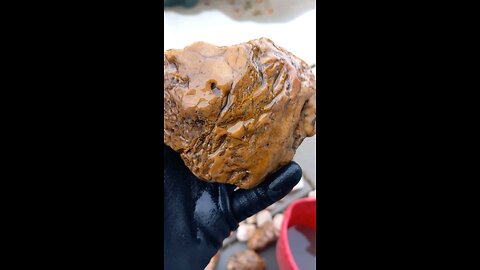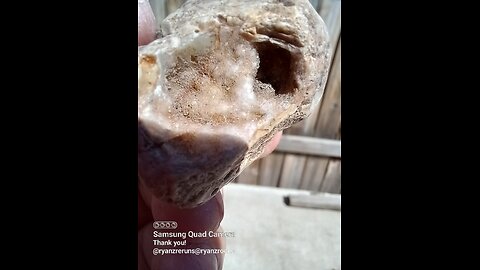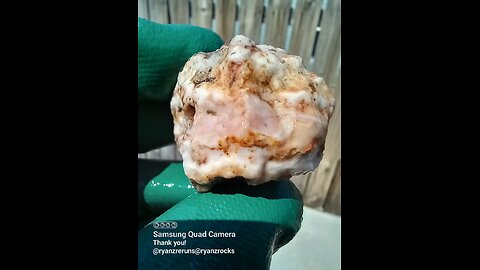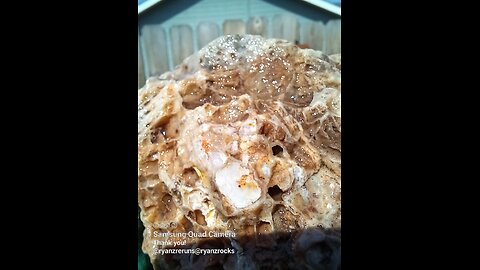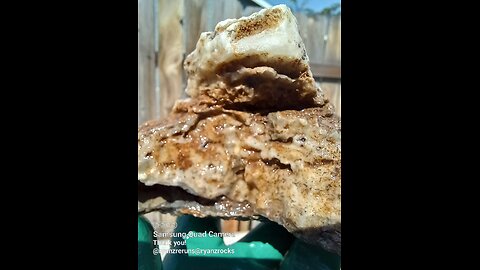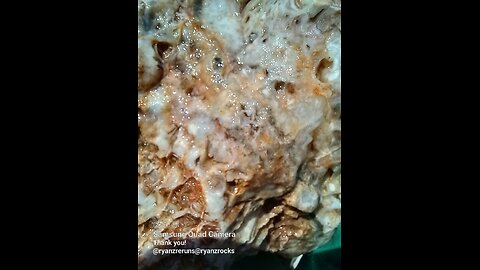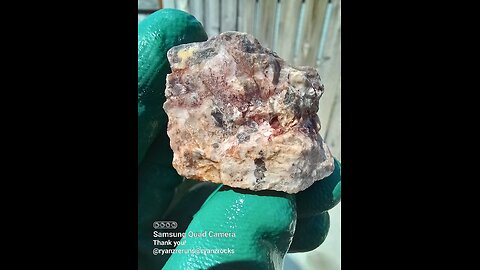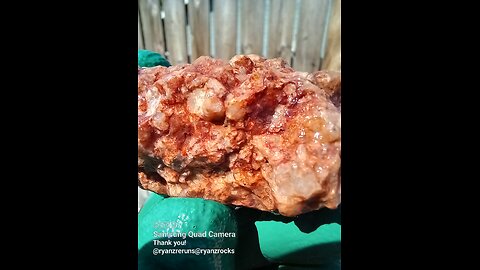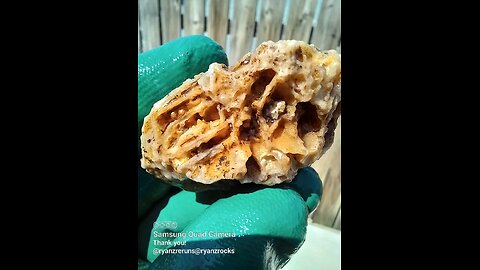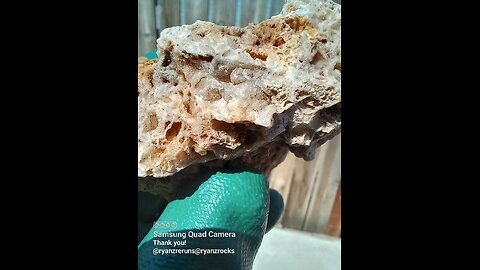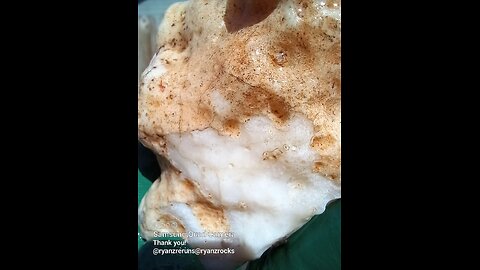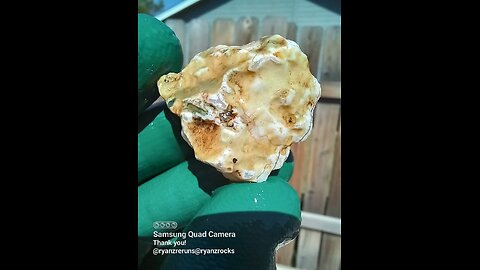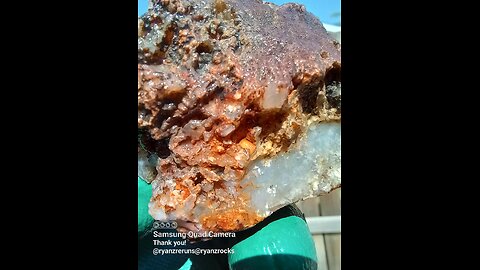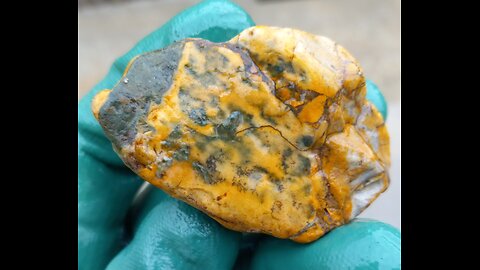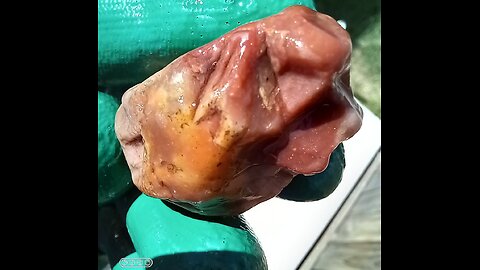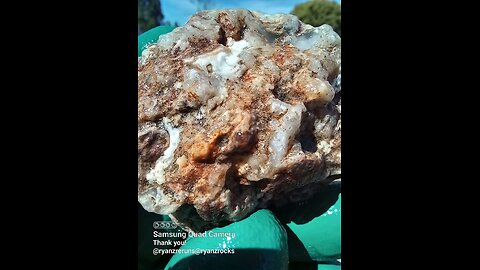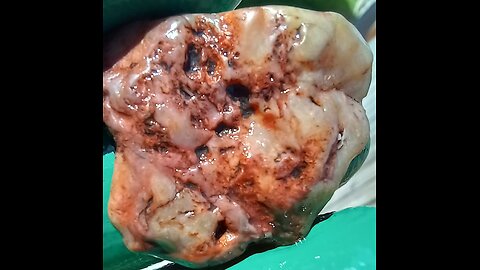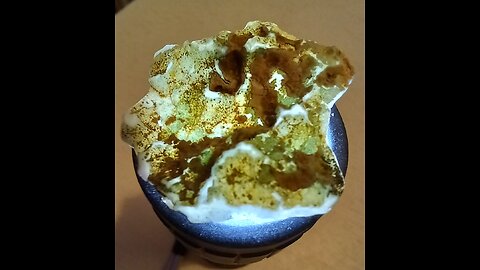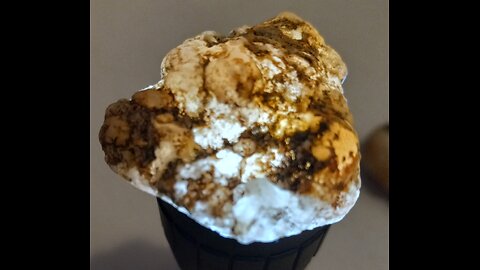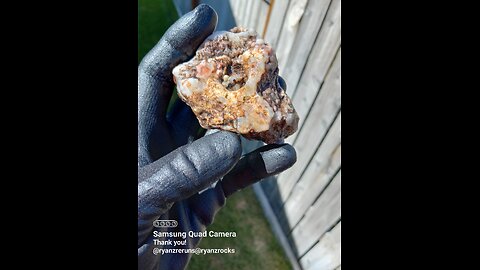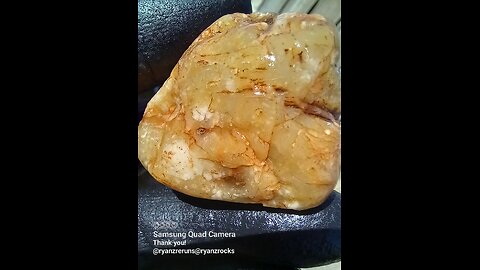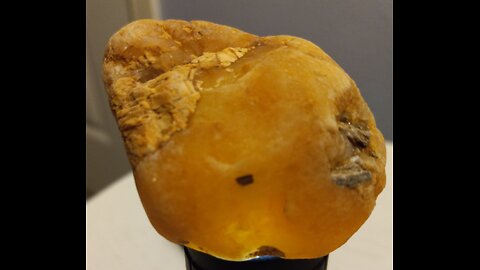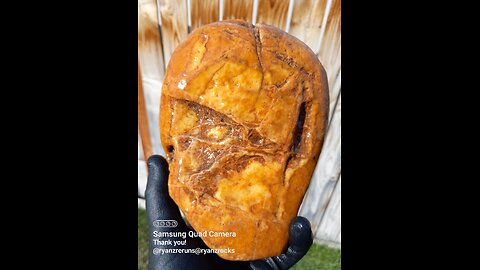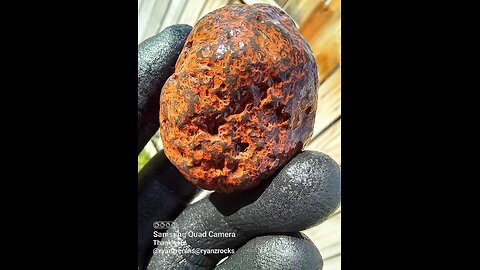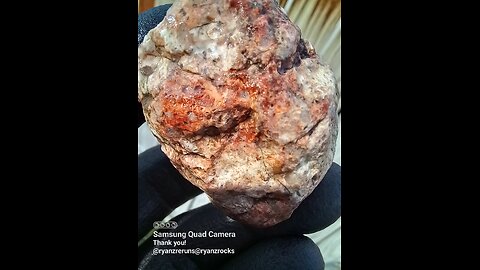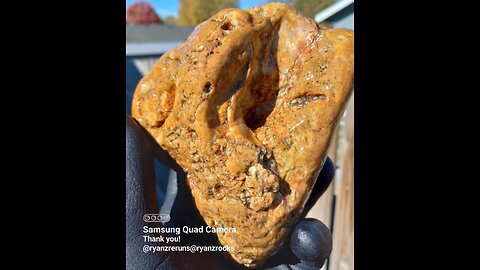Premium Only Content
This video is only available to Rumble Premium subscribers. Subscribe to
enjoy exclusive content and ad-free viewing.

Nodules!
HumbleConservative
- 6 / 46
1
Love the tiny green inside!
HumbleConservative
Agate is a common type of chalcedony, which is a mineral in the quartz family and ia sometimes found in nodule form. It's known for its fine grain and bright, attractive colors, often displaying bands or layers. Here are some different kinds of agate:
Banded Agate: Characterized by its distinct, often concentric layers or bands of different colors. This is often what people think of when they imagine agate.
Moss Agate: Not truly an agate because it doesn't have the typical banding. Instead, it contains green inclusions that resemble moss, which are typically oxides of manganese or iron.
Fire Agate: Known for its fiery appearance, with layers that can display a play of colors due to the iron oxide inclusions. This type is often polished into cabochons for jewelry.
Lace Agate: Features intricate, lace-like patterns that are often more delicate than those of banded agate. Examples include Crazy Lace Agate.
Onyx: Sometimes considered a variety of agate, onyx has parallel bands, unlike the concentric bands of agate. It's commonly black and white but can come in other colors.
Fortification Agate: Named for its pattern that resembles fortifications or landscapes, with angular or curved bands.
Enhydro Agate: Contains water-filled cavities or inclusions. When shaken, you might hear the water inside.
Fairburn Agate: A type of banded agate found near Fairburn, South Dakota, known for its vibrant colors and tight banding.
Botswana Agate: Often features shades of pink, grey, and sometimes apricot, known for its wavy lines and patterns.
Lake Superior Agate: The state gemstone of Minnesota, characterized by its red, orange, and yellow bands, often with a fortification pattern.
Blue Lace Agate: Known for its light blue color with delicate white or darker blue bands, giving it a lace-like appearance.
Dendritic Agate: Contains inclusions that resemble tree-like or fern-like patterns, which are typically black or brown.
Tube Agate: Features tube-like structures within the stone, which can create interesting patterns when cut.
Laguna Agate: From the Laguna area in New Mexico, known for its bright red, orange, and yellow colors with white or black bands.
Sardonyx: Alternating bands of sard (a type of chalcedony, typically brown or red) and white or black onyx.
Each type of agate can have its own local varieties, named after the place where they're found, or based on unique characteristics like color, pattern, or inclusions. Agates are prized not only for their beauty but also for their metaphysical properties in various cultures, often symbolizing grounding, protection, and balance.
2
Bout' lost a finger on this one!
HumbleConservative
An agate nodule refers to a naturally occurring, rounded lump or mass of agate, a common variety of chalcedony and quartz. Agate nodules are prized for their beauty, with layers of different colors and patterns, often formed in volcanic rocks or ancient lava flows. Here's a detailed look at agate nodules:
Formation:
Volcanic Origins: Agate nodules typically form in cavities within volcanic rocks, such as basalt or rhyolite. When lava cools, gas bubbles can become trapped, creating cavities. Over time, silica-rich water fills these cavities, depositing layers of agate.
Layer Formation: The layers or bands in agate nodules are formed through successive depositions of silica from water. Each layer can represent a different period of deposition, with variations in color and pattern due to changes in the mineral content of the water or the environment.
Silica Deposition: As the silica-rich solution fills the cavity, it begins to crystallize from the outer edge towards the center. This can result in concentric layers or bands, giving agate its characteristic appearance.
Characteristics:
Banded Structure: Agate nodules are known for their banded or layered structure. These bands can range in color from white to grey, blue, red, brown, and even black, often in a single nodule.
Durability: Due to their quartz composition, agate nodules are relatively hard (around 7 on the Mohs scale), making them durable for use in jewelry or as decorative stones.
Size: Nodule sizes can vary significantly, from small pebbles to larger masses several inches in diameter. The size often depends on the original cavity size in the volcanic rock.
Types of Agate Nodules:
Banded Agate: Features distinct, often colorful bands, which are agate's most recognized form.
Fortification Agate: Has a pattern that resembles fortifications or landscapes, with sharp, angular lines.
Moss Agate: Not a true agate as it lacks banding but contains moss-like inclusions of green minerals.
Fire Agate: Known for its fiery appearance due to the way light refracts through its layers, often with a botryoidal surface.
Uses:
Jewelry: Agate nodules are cut and polished for use in a variety of jewelry, including rings, pendants, and beads.
Decorative Items: Larger nodules can be carved or polished for use as bookends, paperweights, or display pieces.
Gemstone: When cut into cabochons or faceted, agate from nodules can serve as a gemstone in more formal jewelry settings.
Healing and Metaphysical: Agate is believed by some to have healing properties or to bring balance and protection, leading to its use in alternative medicine or as a talisman.
Collection and Cutting:
Collection: Agate nodules are often found in riverbeds, beaches, or in the field where volcanic rocks outcrop. Collectors might find them as loose nodules or still embedded within the host rock.
Cutting: To reveal the internal beauty, agate nodules are typically cut in half or into sections. This exposes the layers and bands, which can then be polished to a high gloss.
Agate nodules, with their diverse patterns and colors, offer a fascinating glimpse into geological processes, making them not only beautiful but also scientifically interesting. Their wide availability and variety make them accessible to both professional gem cutters and amateur enthusiasts, contributing to their popularity in both the gemological world and as natural art pieces.
3
Big nodule cut!
HumbleConservative
An agate nodule refers to a naturally occurring, rounded lump or mass of agate, a common variety of chalcedony and quartz. Agate nodules are prized for their beauty, with layers of different colors and patterns, often formed in volcanic rocks or ancient lava flows. Here's a detailed look at agate nodules:
Formation:
Volcanic Origins: Agate nodules typically form in cavities within volcanic rocks, such as basalt or rhyolite. When lava cools, gas bubbles can become trapped, creating cavities. Over time, silica-rich water fills these cavities, depositing layers of agate.
Layer Formation: The layers or bands in agate nodules are formed through successive depositions of silica from water. Each layer can represent a different period of deposition, with variations in color and pattern due to changes in the mineral content of the water or the environment.
Silica Deposition: As the silica-rich solution fills the cavity, it begins to crystallize from the outer edge towards the center. This can result in concentric layers or bands, giving agate its characteristic appearance.
Characteristics:
Banded Structure: Agate nodules are known for their banded or layered structure. These bands can range in color from white to grey, blue, red, brown, and even black, often in a single nodule.
Durability: Due to their quartz composition, agate nodules are relatively hard (around 7 on the Mohs scale), making them durable for use in jewelry or as decorative stones.
Size: Nodule sizes can vary significantly, from small pebbles to larger masses several inches in diameter. The size often depends on the original cavity size in the volcanic rock.
Types of Agate Nodules:
Banded Agate: Features distinct, often colorful bands, which are agate's most recognized form.
Fortification Agate: Has a pattern that resembles fortifications or landscapes, with sharp, angular lines.
Moss Agate: Not a true agate as it lacks banding but contains moss-like inclusions of green minerals.
Fire Agate: Known for its fiery appearance due to the way light refracts through its layers, often with a botryoidal surface.
Uses:
Jewelry: Agate nodules are cut and polished for use in a variety of jewelry, including rings, pendants, and beads.
Decorative Items: Larger nodules can be carved or polished for use as bookends, paperweights, or display pieces.
Gemstone: When cut into cabochons or faceted, agate from nodules can serve as a gemstone in more formal jewelry settings.
Healing and Metaphysical: Agate is believed by some to have healing properties or to bring balance and protection, leading to its use in alternative medicine or as a talisman.
Collection and Cutting:
Collection: Agate nodules are often found in riverbeds, beaches, or in the field where volcanic rocks outcrop. Collectors might find them as loose nodules or still embedded within the host rock.
Cutting: To reveal the internal beauty, agate nodules are typically cut in half or into sections. This exposes the layers and bands, which can then be polished to a high gloss.
Agate nodules, with their diverse patterns and colors, offer a fascinating glimpse into geological processes, making them not only beautiful but also scientifically interesting. Their wide availability and variety make them accessible to both professional gem cutters and amateur enthusiasts, contributing to their popularity in both the gemological world and as natural art pieces.
4
Broken nodule!
HumbleConservative
A nodule in geological terms refers to a small, irregularly rounded mass of a mineral or mineral aggregate that has a contrasting composition from the host rock in which it is found. Here are some characteristics and types of nodules:
Composition: Nodules can be composed of various minerals. Common examples include:
Concretions: Often made of minerals like calcium carbonate, iron oxide, or silica. They form by the precipitation of minerals around a nucleus (like a shell, bone, or other debris).
Chert Nodules: These are primarily made of microcrystalline quartz, silica, or opal, often found in limestone or chalk.
Manganese Nodules: Found on the ocean floor, these are rich in manganese and other metals like iron, nickel, copper, and cobalt.
Phosphorite Nodules: These contain high amounts of phosphate minerals, often found in marine sediments.
Formation:
Nodules generally form through diagenesis, the process where sediments are compacted and cemented into rock. The minerals precipitate out of solution around a nucleus, growing over time.
They can also form due to chemical reactions in the sediment or rock, often under conditions where there is a change in the chemistry of the surrounding environment.
Appearance: Nodules are typically hard, with a more or less spherical or elliptical shape, but they can be quite irregular. They often have a smooth surface and might be colored differently from the surrounding rock due to their different mineral composition.
Geological Context: Nodules can occur in various rock types, including sedimentary rocks like limestone, shale, and sandstone. They are particularly common in marine deposits where conditions are favorable for the precipitation of minerals.
When discussing nodules, it's important to specify the type because "nodule" is more a description of form and occurrence rather than a specific rock or mineral type. If you have a specific nodule in mind or find one, examining its composition and the context in which it's found will help in identifying what kind of nodule it is.
5
Nodule with crystals!
HumbleConservative
A nodule in geological terms refers to a small, irregularly rounded mass of a mineral or mineral aggregate that has a contrasting composition from the host rock in which it is found. Here are some characteristics and types of nodules:
Composition: Nodules can be composed of various minerals. Common examples include:
Concretions: Often made of minerals like calcium carbonate, iron oxide, or silica. They form by the precipitation of minerals around a nucleus (like a shell, bone, or other debris).
Chert Nodules: These are primarily made of microcrystalline quartz, silica, or opal, often found in limestone or chalk.
Manganese Nodules: Found on the ocean floor, these are rich in manganese and other metals like iron, nickel, copper, and cobalt.
Phosphorite Nodules: These contain high amounts of phosphate minerals, often found in marine sediments.
Formation:
Nodules generally form through diagenesis, the process where sediments are compacted and cemented into rock. The minerals precipitate out of solution around a nucleus, growing over time.
They can also form due to chemical reactions in the sediment or rock, often under conditions where there is a change in the chemistry of the surrounding environment.
Appearance: Nodules are typically hard, with a more or less spherical or elliptical shape, but they can be quite irregular. They often have a smooth surface and might be colored differently from the surrounding rock due to their different mineral composition.
Geological Context: Nodules can occur in various rock types, including sedimentary rocks like limestone, shale, and sandstone. They are particularly common in marine deposits where conditions are favorable for the precipitation of minerals.
When discussing nodules, it's important to specify the type because "nodule" is more a description of form and occurrence rather than a specific rock or mineral type. If you have a specific nodule in mind or find one, examining its composition and the context in which it's found will help in identifying what kind of nodule it is.
Carmel Chalcedony Nugget!
HumbleConservative
Chalcedony, a microcrystalline variety of quartz. It forms in concentric layers within cavities of rocks, typically igneous rocks such as volcanic basalt. Botryoidal agate forms when layers of silica-rich fluids deposit successive layers of chalcedony around a central nucleus, creating these distinctive rounded shapes.
One of the most intriguing aspects of botryoidal agate is its diverse range of colors and patterns. These patterns are often accentuated by the unique banding and translucency inherent to agate. From vibrant hues of blue, green, and purple to earthy tones of brown and gray, each specimen showcases its own distinct beauty.
7
Cool Nodule!
HumbleConservative
The rock in the image appears to be a type of agate or jasper with interesting inclusions. The coloration and patterns suggest it could be a form of "Chicken Blood Stone" or "Cinnabar Agate," which is known for its red inclusions due to the presence of cinnabar. The white and yellowish areas could be agate or other forms of chalcedony, which often have such colorations due to different mineral inclusions and impurities. These types of rocks are valued for their vibrant colors and are often used in jewelry and decorative items.
8
Now that's a big gash!
HumbleConservative
This rock appears to be an agate nodule. Here are some key points about agate nodules: -
**Agate**: Agates are a type of chalcedony, which is a form of quartz. They are known for their beautiful banding and are found in a variety of colors. -
**Nodule**: A nodule is a rounded or irregular mass of mineral material, often formed within cavities or fractures in rocks. Agate nodules typically form in volcanic rocks or in sedimentary layers. -
**Appearance**: The nodule in the image shows a rough, unpolished exterior with potential banding or color variations inside. Agates often have layers of different colors or translucent bands when cut open. -
**Formation**: Agates form through the deposition of silica from groundwater in cavities, often in volcanic rocks. The silica fills the cavity layer by layer, creating the characteristic banding. -
**Usage**: Agates are popular in jewelry and as decorative stones due to their hardness (around 7 on the Mohs scale) and attractive patterns. -
**Cutting and Polishing**: To reveal the internal beauty, it might need to be cut and polished. This often requires specialized equipment like a rock saw and a tumbler. -
**Identification**: For precise identification, consider the location where it was found, as agates from different regions can have unique characteristics. -
**Value**: The value of an agate nodule can vary. Some are quite common, while others, especially those with unique patterns or colors, can be more valuable. -
**Geological Interest**: Agates are fascinating for their geological history and the processes that form them, making them a subject of interest for both collectors and geologists. If you're looking to learn more or possibly work with this nodule, consulting with a gemologist or joining a rockhounding community could provide further insights and guidance.
9
Some botryoidal goins' on!
HumbleConservative
Agate is a semiprecious gemstone that is a variety of chalcedony, a type of quartz:
Appearance
Agate is known for its concentric bands of color, which can be white, gray, yellowish-brown, reddish-brown, blue, or green. The colors come from iron oxide minerals in the quartz.
Formation
Agate forms in cavities in volcanic and metamorphic rocks over thousands of years. Silica-rich water deposits quartz crystals in layers that are parallel to the cavity walls.
Uses
Agate is a popular choice for jewelry and carvings because of its beauty and toughness. It has been used to make beads, cabochons, and cameos.
Origin
The name agate comes from the river Achates (now Dirillo) in southwest Sicily, where it was discovered. However, some modern etymologists believe the river was named after the stone.
Other names
Agate has many names, including eye agate, lace agate, and moss agate.
Location
Agate is found all over the world, but Brazil is the main commercial source. In the United States, the western states of Oregon, Washington, Idaho, and Montana are the main sources.
10
One 4 cuttin'!
HumbleConservative
This rock has a waxy luster and a coloration that ranges from yellow to brown with some banding, which is quite characteristic of Jasper. Specifically, the yellow and brown hues suggest it could be a variety of jasper known as Yellow Jasper or Brecciated Jasper if there are also darker inclusions or patterns.
Jasper is an opaque, impure variety of silica, typically composed of chalcedony and quartz. It's known for its smooth fracture, which makes it suitable for ornamental and gemstone uses.
Yellow Jasper is appreciated for its warm yellow to mustard colors, often with banding or veining.
Brecciated Jasper features a mixture of jasper with other materials, often appearing as a conglomerate with different colored fragments.
Given its appearance, this rock could be used in jewelry or as a decorative stone due to its aesthetic appeal and durability. If you're interested in using it for such purposes or just want a definitive identification, consider consulting with a geologist or using a rock identification resource that might provide more detailed analysis based on location, texture, and other physical properties.
11
This one got a swirley!
HumbleConservative
#noob #rockhound #rockformation #chert #quartz #quartzite #chalcedony #agates #nodules #sandstone #limestone #tumbling #rocks #rockhounders #rockstructure #metamorphicrocks #metamorphic #igneousrocks #igneous #geology #minerals #crystals #glowrocks #idahorockhunting #idahogems #rockcutting #thundereggs #opal #lavarock #rigidtools #ryobitools #riverrocks #translucentrocks #translucent #rockgarden #flow #vevortools #jasper #granite #caves #marble #carnelian #gneiss #limestone #calcite #gold #silver #botryoidal #geodes
14
17
19
20
21
23
24
Love the Green!
HumbleConservative
@RyanzRocks #noob #rockhound #rockformation #tumbling #agates #rocks #rockhounders #rockstructure #metamorphicrocks #metamorphic #igneousrocks #igneous #quartz #quartzite #geology #nodules #minerals #crystals #glowrocks #idahorockhunting #idahogems #rockcutting #thundereggs #chalcedony #opal #lavarock #rigidtools #ryobitools #riverrocks #translucentrocks #translucent #rockgarden #flow #vevortools #jasper #granite #caves #marble #carnelian #gneiss #limestone #calcite #gold #silver #botryoidal
25
Spud!
HumbleConservative
@RyanzRocks #noob #rockhound #rockformation #tumbling #agates #rocks #rockhounders #rockstructure #metamorphicrocks #metamorphic #igneousrocks #igneous #quartz #quartzite #geology #nodules #minerals #crystals #glowrocks #idahorockhunting #idahogems #rockcutting #thundereggs #chalcedony #opal #lavarock #rigidtools #ryobitools #riverrocks #translucentrocks #translucent #rockgarden #flow #vevortools #jasper #granite #caves #marble #carnelian #gneiss #limestone #calcite #gold #silver #botryoidal
26
Mish Mash of Agate!
HumbleConservative
@RyanzRocks #noob #rockhound #rockformation #tumbling #agates #rocks #rockhounders #rockstructure #metamorphicrocks #metamorphic #igneousrocks #igneous #quartz #quartzite #geology #nodules #minerals #crystals #glowrocks #idahorockhunting #idahogems #rockcutting #thundereggs #chalcedony #opal #lavarock #rigidtools #ryobitools #riverrocks #translucentrocks #translucent #rockgarden #flow #vevortools #jasper #granite #caves #marble #carnelian #gneiss #limestone #calcite #gold #silver #botryoidal
27
Agate nodule!
HumbleConservative
@RyanzRocks #noob #rockhound #rockformation #tumbling #agates #rocks #rockhounders #rockstructure #metamorphicrocks #metamorphic #igneousrocks #igneous #quartz #quartzite #geology #nodules #minerals #crystals #glowrocks #idahorockhunting #idahogems #rockcutting #thundereggs #chalcedony #opal #lavarock #rigidtools #ryobitools #riverrocks #translucentrocks #translucent #rockgarden #flow #vevortools #jasper #granite #caves #marble #carnelian #gneiss #limestone #calcite #gold #silver #botryoidal
28
Botryoidal chalcedony!
HumbleConservative
Plume agate is a variety of chalcedony, a microcrystalline quartz, characterized by delicate, plume-like inclusions of various colors and minerals. These inclusions often resemble feathers, flowers, or flames, giving the agate a unique and visually appealing appearance.
Plume agate only forms in hotsprings with the help of thermophiles and extremophiles (microscopic organisms that like harsh and hot environments) collecting silica and other dissolved particles in silica rich hotsprings and depositing them in wild patterns within the agate.
A combination of clays, metals and minerals make up the cool colors and textures we experience.
There are many famous deposits of plume, flame and other varieties of textures made with the assistance of microbes.
29
Got a little cave in it!
HumbleConservative
@RyanzRocks #noob #rockhound #rockformation #tumbling #agates #rocks #rockhounders #rockstructure #metamorphicrocks #metamorphic #igneousrocks #igneous #quartz #quartzite #geology #nodules #minerals #crystals #glowrocks #idahorockhunting #idahogems #rockcutting #thundereggs #chalcedony #opal #lavarock #rigidtools #ryobitools #riverrocks #translucentrocks #translucent #rockgarden #flow #vevortools #jasper #granite #caves #marble #carnelian #gneiss #limestone #calcite #gold #silver #botryoidal
30
Smooth Shard!
HumbleConservative
@RyanzRocks #noob #rockhound #rockformation #tumbling #agates #rocks #rockhounders #rockstructure #metamorphicrocks #metamorphic #igneousrocks #igneous #quartz #quartzite #geology #nodules #minerals #crystals #glowrocks #idahorockhunting #idahogems #rockcutting #thundereggs #chalcedony #opal #lavarock #rigidtools #ryobitools #riverrocks #translucentrocks #translucent #rockgarden #flow #vevortools #jasper #granite #caves #marble #carnelian #gneiss #limestone #calcite #gold #silver #botryoidal
31
Purdy Agate Nodule!
HumbleConservative
@RyanzRocks #noob #rockhound #rockformation #tumbling #agates #rocks #rockhounders #rockstructure #metamorphicrocks #metamorphic #igneousrocks #igneous #quartz #quartzite #geology #nodules #minerals #crystals #glowrocks #idahorockhunting #idahogems #rockcutting #thundereggs #chalcedony #opal #lavarock #rigidtools #ryobitools #riverrocks #translucentrocks #translucent #rockgarden #flow #vevortools #jasper #granite #caves #marble #carnelian #gneiss #limestone #calcite #gold #silver #botryoidal
32
Glow Shard!
HumbleConservative
The rock in the image appears to be a type of chalcedony, possibly an agate or a similar variety. Here's why:
1. **Coloration and Banding**: The rock has a predominantly white or light gray color with some yellowish-brown inclusions. This kind of coloration and banding is typical for agates, which are a variety of chalcedony.
2. **Translucency**: Chalcedony, including agate, often has a translucent quality, which seems to be present in parts of this rock.
3. **Texture**: The rock's texture looks somewhat waxy or greasy, which is characteristic of chalcedony due to its fine-grained silica composition.
4. **Inclusions**: The yellowish-brown areas could be iron oxide or other mineral inclusions, which are common in agates and give them their varied colors. However, without specific tests like a hardness test, streak test, or chemical analysis, this identification remains speculative. For a more precise identification: - **Hardness Test**: Chalcedony has a hardness of around 7 on the Mohs scale, meaning it should scratch glass but not be scratched by a knife. - **Streak Test**: The streak of chalcedony (if it could be powdered) would typically be white or colorless. - **Microscopic Analysis**: Looking at thin sections under a microscope could reveal the mineral composition more clearly. - **Consulting a Geologist or Using Spectroscopy**: For a definitive identification, especially if this rock might be of value or scientific interest.
33
Nice Glow!
HumbleConservative
The rock in the image appears to be a type of chalcedony, possibly an agate or a similar variety. Here's why:
1. **Coloration and Banding**: The rock has a predominantly white or light gray color with some yellowish-brown inclusions. This kind of coloration and banding is typical for agates, which are a variety of chalcedony.
2. **Translucency**: Chalcedony, including agate, often has a translucent quality, which seems to be present in parts of this rock.
3. **Texture**: The rock's texture looks somewhat waxy or greasy, which is characteristic of chalcedony due to its fine-grained silica composition.
4. **Inclusions**: The yellowish-brown areas could be iron oxide or other mineral inclusions, which are common in agates and give them their varied colors. However, without specific tests like a hardness test, streak test, or chemical analysis, this identification remains speculative. For a more precise identification: - **Hardness Test**: Chalcedony has a hardness of around 7 on the Mohs scale, meaning it should scratch glass but not be scratched by a knife. - **Streak Test**: The streak of chalcedony (if it could be powdered) would typically be white or colorless. - **Microscopic Analysis**: Looking at thin sections under a microscope could reveal the mineral composition more clearly. - **Consulting a Geologist or Using Spectroscopy**: For a definitive identification, especially if this rock might be of value or scientific interest.
34
Did you catch the silver flakes?
HumbleConservative
@RyanzRocks #noob #rockhound #rockformation #tumbling #agates #rocks #rockhounders #rockstructure #metamorphicrocks #metamorphic #igneousrocks #igneous #quartz #quartzite #geology #nodules #minerals #crystals #glowrocks #idahorockhunting #idahogems #rockcutting #thundereggs #chalcedony #opal #lavarock #rigidtools #ryobitools #riverrocks #translucentrocks #translucent #rockgarden #flow #vevortools #jasper #granite #caves #marble #carnelian #gneiss #limestone #calcite #gold #silver #botryoidal
35
Bright Orange Jasper Nodule!
HumbleConservative
The rock in this image appears to be a type of jasper, specifically a brecciated jasper due to its color pattern and texture.
Jasper is an opaque, impure variety of silica, typically composed of quartz and/or chalcedony along with other mineral phases. It's known for its red color, which comes from iron(III) inclusions, but it can also be found in various other colors.
Brecciated jasper is characterized by its broken fragments that have been naturally cemented back together, often showing a mix of colors like red, yellow, brown, and sometimes even hints of purple or pink due to additional mineral impurities or oxidation states.
The texture and the way the colors blend or are segmented in this rock are indicative of this type of jasper. Jasper is commonly used for ornamentation or as a gemstone due to its durability and attractive colors.
36
Jasper Nodule?
HumbleConservative
The rock in this image appears to be a type of jasper, specifically a brecciated jasper due to its color pattern and texture.
Jasper is an opaque, impure variety of silica, typically composed of quartz and/or chalcedony along with other mineral phases. It's known for its red color, which comes from iron(III) inclusions, but it can also be found in various other colors.
Brecciated jasper is characterized by its broken fragments that have been naturally cemented back together, often showing a mix of colors like red, yellow, brown, and sometimes even hints of purple or pink due to additional mineral impurities or oxidation states.
The texture and the way the colors blend or are segmented in this rock are indicative of this type of jasper. Jasper is commonly used for ornamentation or as a gemstone due to its durability and attractive colors.
37
Hot Mess!
HumbleConservative
@RyanzRocks #noob #rockhound #rockformation #tumbling #agates #rocks #rockhounders #rockstructure #metamorphicrocks #metamorphic #igneousrocks #igneous #quartz #quartzite #geology #nodules #minerals #crystals #glowrocks #idahorockhunting #idahogems #rockcutting #thundereggs #chalcedony #opal #lavarock #rigidtools #ryobitools #riverrocks #translucentrocks #translucent #rockgarden #flow #vevortools #jasper #granite #caves #marble #carnelian #gneiss #limestone #calcite #gold #silver #botryoidal
38
Agate Nodule!
HumbleConservative
@RyanzRocks #noob #rockhound #rockformation #tumbling #agates #rocks #rockhounders #rockstructure #metamorphicrocks #metamorphic #igneousrocks #igneous #quartz #quartzite #geology #nodules #minerals #crystals #glowrocks #idahorockhunting #idahogems #rockcutting #thundereggs #chalcedony #opal #lavarock #rigidtools #ryobitools #riverrocks #translucentrocks #translucent #rockgarden #flow #vevortools #jasper #granite #caves #marble #carnelian #gneiss #limestone #calcite #gold #silver #botryoidal
39
Agate Nodule!
HumbleConservative
@RyanzRocks #noob #rockhound #rockformation #tumbling #agates #rocks #rockhounders #rockstructure #metamorphicrocks #metamorphic #igneousrocks #igneous #quartz #quartzite #geology #nodules #minerals #crystals #glowrocks #idahorockhunting #idahogems #rockcutting #thundereggs #chalcedony #opal #lavarock #rigidtools #ryobitools #riverrocks #translucentrocks #translucent #rockgarden #flow #vevortools #jasper #granite #caves #marble #carnelian #gneiss #limestone #calcite #gold #silver #botryoidal
40
Chalcedony Nodule!
HumbleConservative
The rock in the image appears to be a type of chalcedony, possibly an agate or a similar variety. Here's why:
1. **Coloration and Banding**: The rock has a predominantly white or light gray color with some yellowish-brown inclusions. This kind of coloration and banding is typical for agates, which are a variety of chalcedony.
2. **Translucency**: Chalcedony, including agate, often has a translucent quality, which seems to be present in parts of this rock.
3. **Texture**: The rock's texture looks somewhat waxy or greasy, which is characteristic of chalcedony due to its fine-grained silica composition.
4. **Inclusions**: The yellowish-brown areas could be iron oxide or other mineral inclusions, which are common in agates and give them their varied colors. However, without specific tests like a hardness test, streak test, or chemical analysis, this identification remains speculative. For a more precise identification: - **Hardness Test**: Chalcedony has a hardness of around 7 on the Mohs scale, meaning it should scratch glass but not be scratched by a knife. - **Streak Test**: The streak of chalcedony (if it could be powdered) would typically be white or colorless. - **Microscopic Analysis**: Looking at thin sections under a microscope could reveal the mineral composition more clearly. - **Consulting a Geologist or Using Spectroscopy**: For a definitive identification, especially if this rock might be of value or scientific interest.
41
Pretty Yellow Glow Nodule!
HumbleConservative
The rock in the image appears to be a type of chalcedony, possibly an agate or a similar variety. Here's why:
1. **Coloration and Banding**: The rock has a predominantly white or light gray color with some yellowish-brown inclusions. This kind of coloration and banding is typical for agates, which are a variety of chalcedony.
2. **Translucency**: Chalcedony, including agate, often has a translucent quality, which seems to be present in parts of this rock.
3. **Texture**: The rock's texture looks somewhat waxy or greasy, which is characteristic of chalcedony due to its fine-grained silica composition.
4. **Inclusions**: The yellowish-brown areas could be iron oxide or other mineral inclusions, which are common in agates and give them their varied colors. However, without specific tests like a hardness test, streak test, or chemical analysis, this identification remains speculative. For a more precise identification: - **Hardness Test**: Chalcedony has a hardness of around 7 on the Mohs scale, meaning it should scratch glass but not be scratched by a knife. - **Streak Test**: The streak of chalcedony (if it could be powdered) would typically be white or colorless. - **Microscopic Analysis**: Looking at thin sections under a microscope could reveal the mineral composition more clearly. - **Consulting a Geologist or Using Spectroscopy**: For a definitive identification, especially if this rock might be of value or scientific interest.
42
Big ol' nodule!
HumbleConservative
@RyanzRocks #noob #rockhound #rockformation #sandstone #tumbling #agates #rocks #rockhounders #rockstructure #metamorphicrocks #metamorphic #igneousrocks #igneous #quartz #quartzite #geology #nodules #minerals #crystals #glowrocks #idahorockhunting #idahogems #rockcutting #thundereggs #chalcedony #opal #lavarock #rigidtools #ryobitools #riverrocks #translucentrocks #translucent #rockgarden #flow #vevortools #jasper #granite #caves #marble #carnelian #gneiss #limestone #calcite #gold #silver #botryoidal #geodes
43
Nodule w/ reds!
HumbleConservative
@RyanzRocks #noob #rockhound #rockformation #sandstone #tumbling #agates #rocks #rockhounders #rockstructure #metamorphicrocks #metamorphic #igneousrocks #igneous #quartz #quartzite #geology #nodules #minerals #crystals #glowrocks #idahorockhunting #idahogems #rockcutting #thundereggs #chalcedony #opal #lavarock #rigidtools #ryobitools #riverrocks #translucentrocks #translucent #rockgarden #flow #vevortools #jasper #granite #caves #marble #carnelian #gneiss #limestone #calcite #gold #silver #botryoidal #geodes
44
Pretty red agates nodule!
HumbleConservative
@RyanzRocks #noob #rockhound #rockformation #sandstone #tumbling #agates #rocks #rockhounders #rockstructure #metamorphicrocks #metamorphic #igneousrocks #igneous #quartz #quartzite #geology #nodules #minerals #crystals #glowrocks #idahorockhunting #idahogems #rockcutting #thundereggs #chalcedony #opal #lavarock #rigidtools #ryobitools #riverrocks #translucentrocks #translucent #rockgarden #flow #vevortools #jasper #granite #caves #marble #carnelian #gneiss #limestone #calcite #gold #silver #botryoidal #geodes
45
Another nodule with reds!
HumbleConservative
@RyanzRocks #noob #rockhound #rockformation #sandstone #tumbling #agates #rocks #rockhounders #rockstructure #metamorphicrocks #metamorphic #igneousrocks #igneous #quartz #quartzite #geology #nodules #minerals #crystals #glowrocks #idahorockhunting #idahogems #rockcutting #thundereggs #chalcedony #opal #lavarock #rigidtools #ryobitools #riverrocks #translucentrocks #translucent #rockgarden #flow #vevortools #jasper #granite #caves #marble #carnelian #gneiss #limestone #calcite #gold #silver #botryoidal #geodes
46
Agate Nodule!
HumbleConservative
@RyanzRocks #noob #rockhound #rockformation #sandstone #tumbling #agates #rocks #rockhounders #rockstructure #metamorphicrocks #metamorphic #igneousrocks #igneous #quartz #quartzite #geology #nodules #minerals #crystals #glowrocks #idahorockhunting #idahogems #rockcutting #thundereggs #chalcedony #opal #lavarock #rigidtools #ryobitools #riverrocks #translucentrocks #translucent #rockgarden #flow #vevortools #jasper #granite #caves #marble #carnelian #gneiss #limestone #calcite #gold #silver #botryoidal #geodes
Carmel Chalcedony Nugget!
10 months ago
8
Chalcedony, a microcrystalline variety of quartz. It forms in concentric layers within cavities of rocks, typically igneous rocks such as volcanic basalt. Botryoidal agate forms when layers of silica-rich fluids deposit successive layers of chalcedony around a central nucleus, creating these distinctive rounded shapes.
One of the most intriguing aspects of botryoidal agate is its diverse range of colors and patterns. These patterns are often accentuated by the unique banding and translucency inherent to agate. From vibrant hues of blue, green, and purple to earthy tones of brown and gray, each specimen showcases its own distinct beauty.
Loading comments...
-
 LIVE
LIVE
GrimmHollywood
10 hours ago🔴LIVE • GRIMM HOLLYWOOD • RETRO PS2 GAMES • GRIMMDY GAMES • BRRRAP PACK x FINALS RANKED GRIND
82 watching -
 LIVE
LIVE
Cripiechuccles
7 hours ago😁18+💚💙WEEDIE WED WITH CRIPIE💚RUMLUV💙👌SMOKING, GAMING & WATCHING FLICKS!:😁
36 watching -
 1:01:50
1:01:50
BonginoReport
4 hours agoSeason 2 Of The Epstein Show Just Dropped - Nightly Scroll w/ Hayley Caronia (Ep.126) - 09/03/2025
79.1K29 -
 LIVE
LIVE
Spartan
4 hours agoScrims then Ranked and/or E33 (New Game+ / All Enemies 10x Health)
16 watching -
 1:01:42
1:01:42
The Nick DiPaolo Show Channel
5 hours agoUS Vaporizes Venezuelan Drug Boat | The Nick Di Paolo Show #1787
60K35 -
 LIVE
LIVE
LFA TV
14 hours agoLFA TV ALL DAY STREAM - WEDNESDAY 9/3/25
783 watching -
 19:44
19:44
Clownfish TV
13 hours agoMedia Blames MAGA for Literally Everything Now... | Clownfish TV
3.2K7 -
 6:39
6:39
DropItLikeItsScott
4 hours agoLocked In with the AIMWIN PE320 / The Red Dot That Won’t Quit
3.11K1 -
![PROSECUTOR PIRRO: Massive Drug Seizure Exposes China-Cartel Precursor Chemical Route [EP 4704]](https://1a-1791.com/video/fww1/c2/s8/1/O/H/Y/e/OHYez.0kob.2-small-PROSECUTOR-PIRRO-Massive-Dr.jpg) LIVE
LIVE
The Pete Santilli Show
2 hours agoPROSECUTOR PIRRO: Massive Drug Seizure Exposes China-Cartel Precursor Chemical Route [EP 4704]
147 watching -
 1:09:48
1:09:48
Kim Iversen
4 hours agoEPSTEIN VICTIM: We Have The Names. We'll Make The List.
51.9K81

